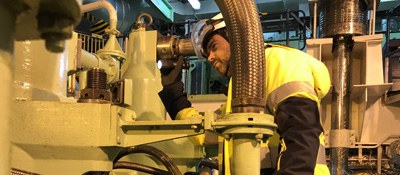Bereich Hafenstaatkontrolle
Brandstwiete 1
20457 Hamburg
Phone: Office Hours +49 40 361 37-297, 24h +49 40 361 37-100
Fax: +49 40 361 37-295
Mail: psc-germany@bg-verkehr.de

Mike Meklenburg
Phone: +49 40 36137-202
Mail: mike.meklenburg@bg-verkehr.de
History • Mission
- The history of port state control begins in Europe
- Mission of port state control
- Legal basis of PSC
- PSC agreements covering other parts of the world
The history of port state control begins in Europe
The history of port state control begins in Europe. In March 1978 the Liberian-flagged oil tanker „Amoco Cadiz“ ran aground off the coast of Brittany/France. The tanker broke into three parts. More than 220.000 tons of crude oil spilled out into the sea, thousands of seabirds perished. The accident was caused by a breakdown of the tanker’s steering gear, insufficient monitoring of the ship’s technical condition, inadequate training of the crew and deficiencies in the safety management on board.
Pictures of stricken seabirds and polluted beaches were seen all over the world and provoked discussions on the causes of the accident.
This was the beginning of port state control. 14 European states agreed to join forces against unsafe ships, poorly trained crews and irresponsible ship owners. Since then, the Paris Memorandum of Understanding - Paris MoU from 1982 on port state control has provided the basis to perform unannounced surveys of foreign-flagged merchant ships calling at ports of the memeber states of the Paris MoU.
Port state control soon proved effective: In due course, the number of ships with numerous deficiencies declined. The permanent threat of possible surveys induced ship owners to take better care of their ships. Currently, the Paris MOU has 27 member states.
The rapid and obvious success in Europe lead the way to developing port state control internationally. This success story had its origin in the Paris MoU.
Mission of port state control
Performance of ship safety surveys rests primarily with the responsible flag state. However, in different flag states quality and intensity of surveys differ widely. This is where port state control gets involved: as „second line of defence“ port state control inspections reinforce the surveys performed by flag states. If individual flag states fail their responsibility, safety deficiencies of ships are at last uncovered at port state control inspections.
Port state control officers check on board of ships whether the international instruments on ship safety, prevention of marine pollution and on working and living conditions of seafarers are complied with.
The inspections are performed according to uniform survey procedures. The inspection results are compiled in a supranational database. Before a ship enters a port, port state control officers are familiar with its „record“. Have previous inspections uncovered excessive deficiencies? Has the ship even been already detained? Such background information helps to identify „substandard ships“ and to target them with priority.

Legal basis of port state control
The legal bases of port state control in German ports are:
- the SOLAS Convention (chapter 1 regulation 19),
- IMO Resolution A.1185(33),
- the Paris Memorandum of Understanding - (Paris MoU,
- of European law the Directive 2009/16/EC and
- of German law § 12 of the "Schiffssicherheitsverordnung" (Ship Safety Ordinance) and § 138 of the "Seearbeitsgesetz" (maritime labour act).
Port state control agreements covering other parts of the world
Important agreements other than the Paris Memorandum of Understanding (Paris MoU) are:
- Viña del Mar Agreement (Latin American Region, since 1993)
- Tokyo MOU (Asia/Pacific Region, since 1994),
- Caribbean Memorandum of Understanding (since 1994),
- Mediterranean Mou (Mediterranean Sea, since 1997),
- Indian Ocean Memorandum of Understanding (India/ East Coast of Africa, since 1999),
- Abuja MoU (West and Central Africa, since 1999),
- Black Sea MOU (since, 2000),
- Riyadh MoU (Persian Golf, since 2005).
Some members of the Paris MoU are also represented in other agreements. E. g. Canada is also a member of the Tokyo MoU. Malta and Cyprus are not only members of the Paris MoU, but also of the Mediterranean MoU and Bulgaria as well as Romania are in addition members of the Black Sea MoU. In U.S. ports the U.S. coast guard conducts port state controls.

